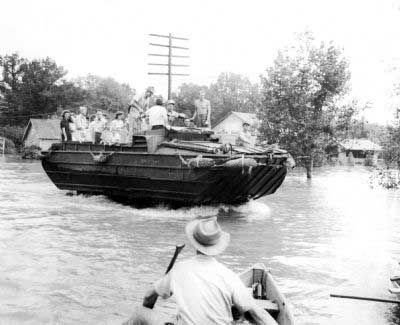 Homestead
Homestead
In September 1945, the Homestead Hurricane caused widespread damage in coastal North Carlina. What then became a tropical storm system produced heavy rainfall over the state, peaking at 14.8 inches in Rockingham in the period Sept. 13-18. The storm led to drenching rainfall, which saturated grounds. The Cape Fear River came out of its banks after cresting in Fayetteville to a record height of 68 feet, causing massive urban flooding along Person Street to Market Square. Fort Bragg soldiers used Army boats to make rescues.
Hazel
On Oct. 15, 1954, Hurricane Hazel made landfall near the North Carolina/South Carolina border with a 40-mile eye. Landfall intensity was estimated at 140 mph, or a Category 4, on the Saffir-Simpson scale. The eye of Hazel was tracked across sev-eral communities in North Carolina, including Fayetteville, as the system continued northward. The storm proceeded through Virginia and Maryland to Pennsylvania and the southern tier of New York. Ha-zel is the benchmark by which hurricanes have been measured in eastern North Carolina, until now.
Unnamed storm
On Sept. 15, 1989, a localized, violent cluster of severe thunderstorms stalled over the city of Fayetteville. Intense rainfall – as much as 7.2 inches in six hours according to the National Weather Service – fell in parts of the city. The resulting runoff severed gates at the Clark Pond dam and breached dams at Country Club Lake, Evans Lake and Lock-wood Pond, resulting in flash floods that struck much of the city without warning. A dozen earthen dams were also breached. Two small children drowned when they and five others tried to abandon their stalled minivan on Morganton Road.
By the time the water receded, 925 acres in the city along Cross and Blounts Creeks and their tributaries had been inundated. It was the most extensive flood in Fayetteville since 1945, with much of the damage resulting from flooding of the Cape Fear River. The event occurred one week before Hurricane Hugo struck the Carolinas.
Fran
Hurricane Fran occurred in September 1996. Fran peaked as a 120 mph, Category 3 hurricane Sept. 5. She weakened slightly before making landfall near Cape Fear, North Carolina. The eye of the storm passed over Clinton, 30 miles east of Fayetteville. Local winds were recorded at 80 mph. Rain of up to 16 inches deluged interior North Carolina, Virginia and West Virginia. Overall, 27 fatalities and $5 bil-lion in damage was attributed to Fran. In North Carolina, 1.3 million people were left without power, including thousands in the greater Fayetteville area.
Matthew
On Oct. 3, 2016, the governors of Florida and North Carolina declared a state of emergency as Hurricane Matthew approached. The next day, South Carolina’s governor ordered an evacuation of residents living within 100 miles of the coast. Twenty-five people died in storm-related incidents across North Carolina. More than 680,000 North Carolinians were without power at one point. Sec-tions of Interstate 95 in the tar heel state had to be shut down for several days as a result of hurricane flooding. Just as happened in the fall of 1989, one week before Hurricane Matthew, 10 inches of rain had drenched Cumberland and adjoining counties. Matthew dumped another 14 inches. The Lumber River reached a record 24 feet in Lumberton.
Florence
Were it not for the Jordan Dam opened 35 years ago on the Cape Fear River in Chatham County, this month’s flooding of the river in Fayetteville would likely have equaled or exceeded that of 1945. The river rose to within a foot of the Person Street bridge in downtown Fayetteville. Cross Creek and Blount’s creeks came out of their banks, flooding nearby ar-eas. Most reports indicated that Fayetteville’s Public Works Commission restored electricity to its service area faster than other power providers that serve some areas of Cumberland County.
The city and FEMA this week began collecting storm-related debris. Residents are asked to be patient with storm debris pickup; it may take weeks to be completed. The Jordan Dam and Lake can be traced to the Homestead Hurricane, which became a tropical storm that struck the Cape Fear River Basin 73 years ago. Construction began in 1967, and con-gress named the project in 1973 in honor of B. Everett Jordan the former Senator from North Carolina.

 How to resolve AdBlock issue?
How to resolve AdBlock issue? 









